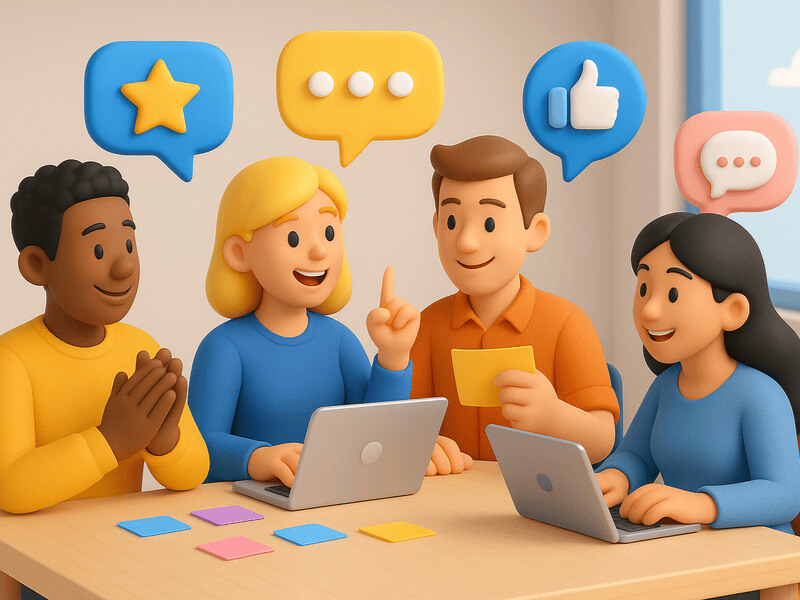
What is continuous employee feedback?
The beauty of continuous employee feedback is that it is a highly dynamic tool available to anyone. What is more, you and your podunk team of disengaged, grumbling employees have the potential to transform into a continuous feedback paradise. A place where everyone is 100% committed and engaged, focused on lifelong learning and being the best they can be so that your company breaks through the sound barrier to become a thousand times better than you ever expected to be.
Hey, let me take that back. You might not break any sound barrier. You might not even get more than twice as good as you expected to be. But still, that's pretty good! Continuous employee feedback might not be magic, but it is an incredibly effective employee performance management technique that can actually give you real transformational results.
How, you wonder? We'll get to that. First, let's start with the technicalities! What exactly is continuous employee feedback?
The continuous employee feedback model is a tool that works well in any industry or level of management for companies that want to boost their performance by taking the time to be attentive to employees' needs. It entails continuous feedback, continuous improvement, continuous communication, and continuous training.
Sounds good so far? It gets better! By implementing a continuous feedback loop in your organization, you'll open up a never-ending improvement cycle that gets better with every repetition! In layman terms, it looks something like collect feedback->look at that feedback -->decide what to do with that feedback --> do it --> get more feedback --> look at that feedback -->decide what to do with that feedback and on and on ad infinitum. It's better than that, though, because it's powered by engaged employees who get more and more empowered with every reiteration, and a team that is excited to be developing and growing and becoming better every day.
Pros and cons for continuous employee feedback
The beauty of this method is that -- but wait, I am getting ahead of myself here. Before I wax poetic and completely lose my outline, let's have a brief look at what the pros and cons of continuous employee feedback are:
PROS: continuous employee feedback can be used in any company for continuous improvement, continuous communication, and continuous training. The result is high employee engagement and a super-boosted performance that will help your company to reach new heights.
CONS: continuous employee feedback isn't the best tool to use when you want to take out some aggression on underperforming employees, unless of course, you want to do continuous performance management by implementing continuous firing.
Got it? Good! Now that we know the pros and cons of continuous employee feedback, let's get into how you can implement continuous feedback in your own company:
Making continuous employee feedback real at your organization
The first step is to appoint a continuous feedback champion. This person will be responsible for initiating continuous improvement loops and continuous communication in your company. This person will also be responsible for continuous training, continuous performance management for employees, and continuous prioritizing of continuous employee feedback projects. If that person turns out to be you, well, aren't you lucky! Seriously, though, it's not a bad job.
The next step is to look at the current state of continuous employee feedback in your organization. Are people continuously communicating across hierarchical levels? Are continuous performance management loops being created and continuous training activities being conducted? Are people giving kudos to each other when kudos are due, and constructive criticism when that becomes necessary? [If your answer to all of this is no, don't worry: there's nothing wrong in starting from ground zero!]
This part is quite simple, but it can be time-consuming. You need to make sure that you are ready to take continuous feedback to the next level. The first thing you need to do is to take continuous training seriously. How will you know what continuous feedback needs continuous improvement if your employees don't continuously learn? Make employee development courses, seminars, and online training days available to your employees whenever necessary. Instant feedback is great, but especially so if it leads to an instant response! Provide both training and feedback on an ongoing, consistent basis for maximum employee growth. If you want your continuous feedback model not only to work but also to leave a lasting impression, it has to be part of an ongoing conversation! Pulse surveys, 360-degree feedback, and regular weekly check-ins are all valid parts of a continuous feedback mechanism when connected to developmental opportunities
After implementing continuous training and continuous feedback in your organization, you need to make sure that continuous performance management is always at the ready. Don't overdo the negative feedback unless you want an insecure, incapable team. If employees feel that continuous firing is a possibility, they will have a continuous fear of continuous failure, which means continuous underperformance! That's not what you want to happen, so choose continuous performance management carefully and give your criticism only with good reason and in a constructive manner.
The final, and arguably the most important step towards continuous feedback is continuous communication. That means making sure that information about constructive feedback gets across all hierarchical levels and as fast as possible! The faster this happens, the more empowered people become. In turn, that will lead to a team that not only does continuous work but also continuous learning.
Continuous employee feedback for remote teams
This works for anyone, everywhere, from big companies to tiny mom-and-pop businesses with three (yes, 3) employees. But there's one other situation we should cover in a little more detail: continuous employee feedback for remote teams.
So, continuous training and continuous feedback are the same: continuous training will help your remote team members to perform better at their jobs and continuous feedback will provide them with continuous guidance on how they can do it. Continuous performance management is also the same: check-ups and development opportunities are possible for remote teams just the same as it is for co-located teams.
The main difference when it comes to continuous remote feedback dialogue between co-located and continuous remote teams is the way your continuous communication takes place. If your team all shares a physical workspace, you can give feedback in person or passing around feedback cards and traditional employee surveys. When your team is spread out, you'll have to look at other options! Some ways of giving feedback might be through continuous emails, continuous webinars, continuous phone calls or if you want to get continuous engagement with continuous activities, you can even do it through continuous videoconferencing!
That all might just get too much for your already overwhelmed virtual worker, though. Rather than distract from his (or her!) already full workday with stressful interactions, consider implementing feedback software like Matter (a free Slack app!) to make ongoing feedback easy and stress-free. Using Matter is so easy that you probably want to implement it even if none of your team is virtual. Sending kudos, constructive criticism, and helpful performance feedback has never been easier than with this handy, lightweight app.
More tips on continuous employee feedback
Before I wrap this article up, here are a few tips you want to keep in mind as you work on that continuous feedback culture that is going to transform your workforce:
- Make continuous employee feedback continuous. That means continuous learning, continuous guidance, and continuous support in your remote team's continuous dialogue about continuous improvement!
- Keep continuous feedback going across all hierarchical levels. Don't let it get trapped within silos or you'll end up with a culture of deafening ignorance instead of inspiring knowledge!
- Don't skimp on positive feedback. Research shows that an employee needs five pieces of positive feedback for every one piece of criticism to function ideally. Effective feedback is detailed, constructive, and leaves the recipient feeling good about himself/herself.
- Make sure that the people who give continuous feedback feel continuously encouraged to do it. That means time in the calendar for feedback and ongoing kudos no matter how much or how little you appreciate their contributions.
Making continuous performance feedback and developmental feedback part of your performance management system can completely change your company culture, bringing employee morale and employee satisfaction to high levels as you plug into employee goals and get regular feedback on what matters to your team. I hope that this article has helped you to take continuous employee feedback to the next level and that you are looking forward to continued success with continuous training, continuous performance management, continuous learning, and continuous kudos.
























